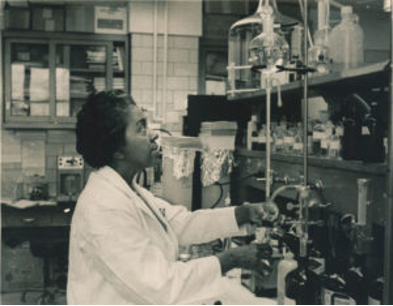-Written by Noel Jackson | NSF GRFP 2021 Fellow | BBS PhD Candidate –
Mair Lab | Department of Molecular Metabolism

Image credit: Archives of the Albert Einstein College of Medicine, Ted Burrows, photographer.
Two hundred and fifty years ago an obscure man named Leeuwenhoek looked for the first time into a mysterious new world peopled with a thousand different kinds of tiny beings, some ferocious and deadly, others friendly and useful, many of them more important to mankind than any continent or archipelago. As a little girl in her grandparents’ library, these words from de Kruif’s “Microbe Hunters” piqued Dr. Marie Maynard Daly’s interest in science. Throughout her research career, Dr. Daly made notable contributions to our understanding of the macromolecular building blocks including nucleic acids, carbohydrates, lipids, and amino acids. She has co-authored papers with groundbreaking findings on the biochemical nature of histones and metabolic enzymes, the synthesis and organization of proteins, and the relationship between cholesterol and hypertension and atherosclerosis.
Daly was born in 1921 in Queens, New York to a mother who loved to read aloud to her and a father who studied chemistry during his brief time at Cornell University before he had to leave due to economic hardships. As a student at Hunter College High School, Daly developed a passion for chemistry. Encouraged by her teachers at Hunter, she enrolled in Queens College where she earned her Bachelor’s degree in chemistry. In 1943, she won a fellowship and completed her Master’s in chemistry at New York University. Throughout her Bachelor’s and Master’s studies, Daly served the science community by working as a part-time lab assistant and chemistry tutor at Queens College.
In the early 1940s, Daly began her doctoral studies at Columbia University under the guidance of the chemist and Bogotá, Columbia native, Dr. Mary L. Caldwell. The lab specialized in the digestive enzyme, amylase. Daly contributed to uncovering answers about how amylase aids in the digestion of corn starch and summarized her work in her dissertation entitled, “A Study of the Products Formed by the Action of Pancreatic Amylase on Corn Starch.” She finished in 1947, making her the first African American woman to be awarded a PhD in chemistry.
After earning her PhD, Daly spent two years teaching at Howard University in Washington, DC while applying for funding to begin her postdoc. Through a grant from the American Chemical Society, Daly started postdoctoral studies in 1949 in the lab of Alfred E. Mirskey at the Rockefeller Institute in New York. While in the lab for seven years, she characterized molecular components in the nucleus and studied their metabolism. She examined anabolism of proteins after fasting and helped uncover the amino acid composition of histones. Most of her work on the foundations of molecular biology and cellular metabolism was published with co-authors Mirskey and Vincent G. Allfrey in The Journal of General Physiology. Her studies on ribonucleoproteins and protein synthesis were described as influential when James Watson and colleagues won the 1962 Nobel Prize for discovering the structure of DNA.
Daly served as an assistant and associate professor at Albert Einstein College of Medicine in the 1960s where she devoted her time to studying the contributions of lipids and age on hypertension and heart disease in rats. She also examined the influence of lifestyle choices, such as diet and smoking, on metabolic diseases and the metabolism by creatine in muscle cells. In addition to her research contributions, Daly also worked to improve access to reach for historically underrepresented minority scientists like herself. In 1975, she joined other women in an American Association for the Advancement of Science meeting to discuss the challenges of being a woman of color in science and publishing their work. She also established the Ivan C. and Helen H. Daly Scholarship at Queens College to encourage minority scientists in the physical sciences.
Sources & Further Reading:
https://undark.org/2017/08/07/unsung-marie-maynard-daly-women-stem/
https://www.sciencehistory.org/historical-profile/marie-maynard-daly
https://encyclopedia-womannica.simplecast.com/episodes/steminists-marie-daly/transcript
http://web.mit.edu/cortiz/www/Diversity/1975-DoubleBind.pdf
http://chargedmagazine.org/2020/04/hidden-figures-beyond-marie-maynard-daly/
https://blogs.scientificamerican.com/urban-scientist/you-should-know-dr-marie-daly/
https://www.einsteinmed.edu/education/phd/current-students/events/Marie-Daly-Celebration.aspx



